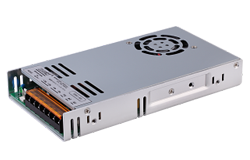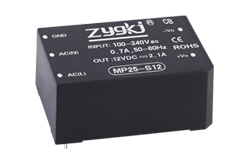소식
AC-DC Converter Circuit: Design and Implementation
저자: ZYG 전원 모듈 Time: 2023-5-3
AC-DC Converter Circuit: Design and Implementation
An AC-DC converter circuit is a device that converts alternating current (AC) to direct current (DC). This type of circuit is commonly used in electronic devices to provide power for their internal components. In this article, we will discuss the design and implementation of an AC-DC converter circuit.
Design
The first step in designing an AC-DC converter circuit is to determine the requirements of the circuit. This includes the input voltage and frequency, output voltage and current, and any other specifications that are required for the specific application.
Once the requirements have been determined, the next step is to choose the appropriate circuit topology. There are several different topologies that can be used for an AC-DC converter circuit, including the buck converter, boost converter, and flyback converter.
The choice of topology will depend on the specific requirements of the circuit, as well as other factors such as cost, size, and efficiency. For example, a buck converter is a good choice for applications where the input voltage is higher than the output voltage, while a boost converter is a good choice for applications where the input voltage is lower than the output voltage.
After selecting the appropriate topology, the next step is to choose the components for the circuit. This includes choosing the diodes, capacitors, inductors, and other components that are required for the specific topology.
Implementation
Once the design is complete, the next step is to implement the circuit. This involves assembling the components on a printed circuit board (PCB) and soldering them in place.
During the implementation phase, it is important to follow best practices for circuit design and assembly, including proper grounding, shielding, and component placement. This will help to ensure that the circuit functions properly and is reliable.
After the circuit has been assembled, the next step is to test it. This involves connecting the circuit to a power source and measuring the output voltage and current. If the circuit does not meet the desired specifications, adjustments may need to be made to the design or components.
결론
In conclusion, designing and implementing an AC-DC converter circuit requires careful consideration of the requirements of the circuit, the choice of topology, and the selection of components. By following best practices for circuit design and assembly, it is possible to create a reliable and efficient AC-DC converter circuit for a wide range of electronic applications.
이전의: AC-DC Converter Module: The Key to Efficient Power Conversion
다음: Title: High-Efficiency Industrial AC-DC Converter for Power Conversion Applications
관련 정보
-
2023-8-18
Customized Electric Power Series: Harnessing the Energy Revolution
Introduction: In recent years, the world has witnessed a growing demand for electricity, driven by population growth, urbanization, and industrialization. However, this surge in demand has also led to increased concerns about the sustainability, cost, and environmental impact of traditional energy sources. As a result, there has been a significant push towards harnessing the energy revolution - the adoption of cleaner and renewable sources of electric power. In this article, we will explore the various technologies and advancements that are paving the way for a sustainable energy future. 1. Solar Power: Solar power has emerged as one of the most promising sources of renewable energy. With the advancements in photovoltaic (PV) technology, solar panels have become more efficient and affordable....
세부 정보보기 -
2023-8-30
The Electric Power Series: Energizing English Learning
As the world becomes increasingly globalized, the ability to communicate in English has become more important than ever. English is not only the universal language of business, but it also plays a crucial role in academic and social settings. In response to this growing demand, a revolutionary language-learning program called The Electric Power Series has been introduced to energize and enhance English learning. The Electric Power Series is a comprehensive and interactive English language program designed to cater to learners of all ages and levels. It focuses on optimizing language acquisition through the use of cutting-edge technology and innovative teaching methodologies. By incorporating elements of gamification, multimedia, and real-life scenarios, this program aims to make English learning engaging, meaningful, and...
세부 정보보기 -
2023-4-18
Building a 120 Volt AC Power Supply for 3 Volts DC
Introduction: In this article, we will discuss how to build a 120-volt AC power supply for 3 volts DC. This process requires some basic knowledge of electronics and safety measures. We will provide step-by-step instructions to help guide you through the process. Materials Required: - Transformer (120V to 12V AC) - Bridge rectifier - Capacitor (1000uf, 16V) - Voltage regulator (LM7803) - Heat sink - Wires - Soldering iron and solder - Wire stripper - Pliers - Safety glasses Step 1: Safety Precautions Before starting any electrical project, it is essential to take safety precautions to avoid electrical shocks or fires. Wear safety glasses to protect your eyes from soldering fumes. Ensure that the circuit is unplugged from the power...
세부 정보보기 -
2023-8-31
The Electrifying Power Series: Unleashing the Potential of Electricity
Introduction Electricity is an integral part of our lives, powering our homes, industries, and transportation systems. It is a form of energy that has revolutionized the way we live and has become the backbone of modern society. In this article, we will explore the electrifying power series, which aims to unleash the full potential of electricity. Chapter 1: The History of Electricity To understand the potential of electricity, we must first delve into its history. The discovery of electricity dates back to ancient times, with the observation of static electricity by the Greeks and the invention of the Leyden jar by a Dutch physicist in the 18th century. However, it was not until the late 19th century that electricity became...
세부 정보보기 -
2023-4-28
Industrial AC-DC Converter: Efficient and Reliable Power Conversion
An industrial AC-DC converter is a device used to convert electrical power from alternating current (AC) to direct current (DC). This type of converter is commonly used in industrial settings where reliable and efficient power conversion is essential for the smooth operation of equipment and processes.The basic function of an AC-DC converter is to take the AC power supplied by the utility grid and convert it to DC power that can be used to power electronic devices and equipment. This conversion process involves a number of components including transformers, diodes, capacitors, and transistors.One of the primary benefits of using an industrial AC-DC converter is that it allows for more efficient use of electrical power. AC power is commonly used in...
세부 정보보기 -
2023-8-19
Introducing the SP Series AC-DC Converter: Powering Your Devices with Efficiency and Reliability
The demand for efficient and reliable power supply solutions has never been greater. Whether it's our smartphones, laptops, or household appliances, we rely heavily on these devices to stay connected and productive. That's why its crucial to have a power converter that can meet our energy demands without compromising on efficiency and reliability. Introducing the SP Series AC-DC Converter – the perfect solution to power your devices. The SP Series AC-DC Converter is designed to provide a stable and efficient power supply for a wide range of devices. With its cutting-edge technology and advanced features, this converter delivers exceptional performance and reliability, making it the go-to choice for both residential and industrial applications. One of the key features of the...
세부 정보보기


















